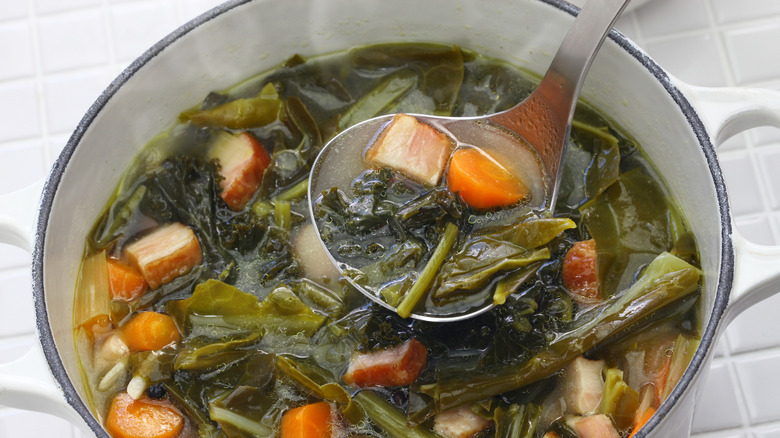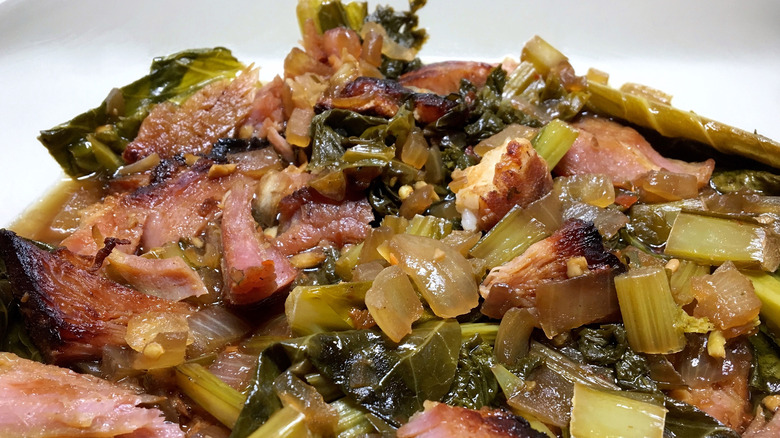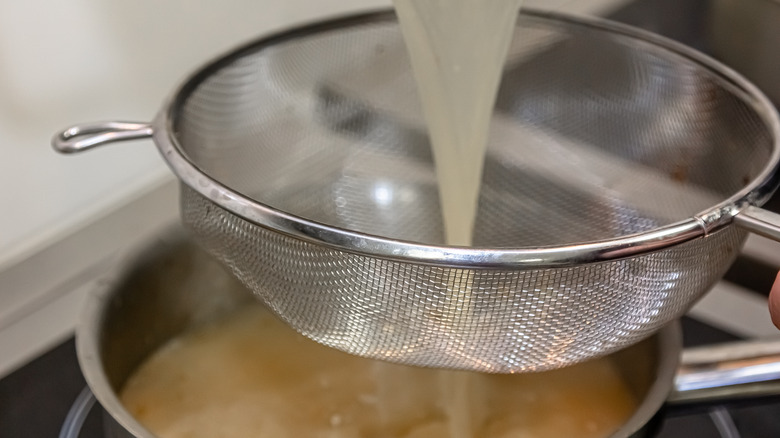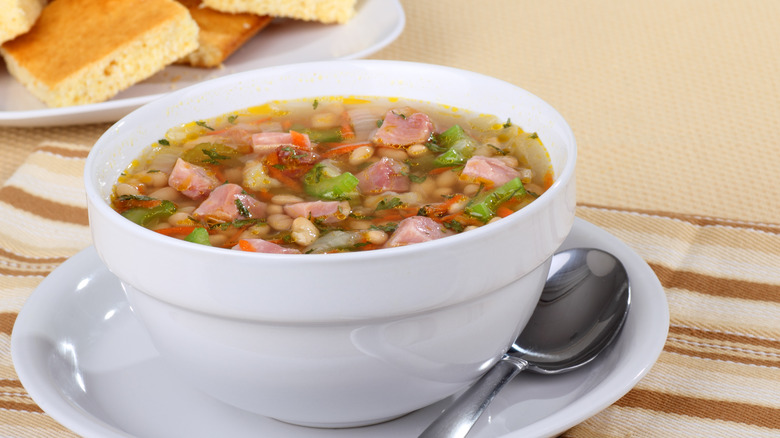Potlikker Is A Simple Soul Food Dish With A Deep History
The broth left from cooking up a "mess of greens" (Southern term for a pot filled with varieties such as turnip or collard greens and kale), otherwise known as potlikker — or pot liquor — is quite simple. In its most basic form, you may think that maybe the chef didn't stew the greens down enough because the simple braise remains. And, especially if you weren't raised on the stuff, you may be tempted to throw out this bitter bonus. Trust us, you would kick yourself for doing so.
Loaded with Vitamin C, Vitamin K, Vitamin A, and iron, per Advocate Aurora Health, generations have drunk the broth as a tonic steeped in Black history. "When people think about soul food, they think of heavy dishes like gravies, macaroni and cheese, and candied yams," Nashville-born chef Carla Hall told Bon Appétit. "I want to highlight potlikker as a cultural connection to soul food." Hall grew up like many Southerners, eating potlikker without missing a beat. Now as an adult, she wants to highlight it as an "accessible" way to create deep flavors in dishes. But, how can something so simple be so complex?
The history of potlikker
You can't talk about potlikker without acknowledging its original intent. Dipping a starch like the Ethiopian injera or Nigerian fufu into a vegetable and meat-based sauce stems from age-old African traditions, according to Black Foodie. That vegetable and meat-based sauce is the potlikker.
What we now know as soul food is the result of enslaved Africans in the South preserving their food traditions using rations of poor value. In considering the quality of these rations, slave owners chose to only provide the enslaved with scrapped animal parts such as pig's stomach and ham hocks, not the choice cuts such as pork loin and shoulder that the owner would've held aside, according to Shwen Shwen. These meager means presented the very crux of soul food which revolved around the enslaved's innate adaptability — birthing such an important American cuisine rooted elsewhere, as Black Foodie reiterates.
As American slave cooks finished preparing greens for their white slaveowner's families, according to The Atlantic, they would pour off the liquid to bring back to their own families for the sustenance now known as something we'd like to think of as a mother sauce of soul food. And, just like back home, it was all about the dipping, except with cornbread because corn was their most common ration, cites U.S. History Scene. To this day, whether to dunk or crumble cornbread into the potlikker remains up for debate.
How it's made
"Once you make the potlikker, everything else is easy," Carla Hall told Bon Appétit. Her country ham potlikker starts with ham, garlic, salt, and crushed red pepper flakes simmered in a quart of water. After about an hour, the flavorful liquid is strained and ready to use as the base of other dishes. While the First Lady of Southern Cooking, Edna Lewis, wrote in her book "In Pursuit of Flavor" that the prime choice for cooked greens is smoked shoulder she clarifies that, "It is the flavor of the smoked meat, not the fat, that makes the greens taste so good."
That being said, if you're vegetarian, Atlas Obscura suggests replacing the pork with mushrooms. This Serious Eats recipe calls for rehydrated dried mushrooms along with one pound of fresh cremini mushrooms that help the potlikker take on the umami flavors also found in salted pork. And, just as Lewis noted that the secret is in the flavor, not the fat, Bryant Terry, author of Vegetable Kingdom, uses a bouquet garni of herbs in his rich vegetable stock (an adapted version of potlikker) as featured in Southern Living.
Whether you use meat or vegetables and herbs to create such a flavor bomb, potlikker is nothing without the slow simmer of a mess of greens, like the collards that chef Vivian Howard simmers for over an hour in potlikker, per CBS News.
Ways to use it
If you have any left after all that crumbling and dunking, potlikker also makes an excellent nutrient-rich base for all sorts of dishes. Think of its applications much like you would use stock or bone broth. You could use the broth to make a simple soup, or use it as a flavor base for other dishes.
Carla Hall's Smoked Paprika and Sun-Dried Tomato Potlikker is the base for the most succulent Braised Chicken Thighs with Olives and Herbs. Chef James Huff utilized his potlikker for a black eyed pea and clam sauce that he poured over a whole fish during his stint at Pearl Dive in Washington, D.C., as reported by NPR.
Or maybe you'd like to take it on the road for a little research and discovery of your own? The Collard Festival in Ayden, North Carolina is a perfect jumping off point where area chefs and home cooks can show you how they use the collard's potlikker, as is the Turnip Green Festival at the Nashville Farmers Market in Tennessee for tasting potlikker in its purest form. From there, get creative with your newfound appreciation for potlikker and cook up something simple and nourishing rooted in African American history.



